In a world where over 7,000 languages are spoken, and global communication is more important than ever, AI-powered translation apps like DeepL are changing how we connect.
Whether you’re a business expanding to new markets or a traveler navigating a foreign country, instant and accurate translation is no longer a luxury, it’s a necessity.
In fact, the AI translation market is expected to reach $3.5 billion by 2026, growing rapidly thanks to advances in machine learning and natural language processing.
DeepL has stood out for its human-like translation quality, outperforming big names like Google Translate in many language pairs. So, what makes DeepL so effective, and how can you build an AI translation app like DeepL to compete?
In this blog post, we’ll explore the key technologies behind DeepL, the steps to create an app like DeepL, and what features users really want. If you’ve ever dreamed of building a smart, seamless translation tool, this guide is your starting point.
So, let’s begin!
What is a DeepL App?
The DeepL App is a powerful language translation tool developed by DeepL GmbH. It offers fast and highly accurate translations using advanced artificial intelligence and neural network technology.
Available on desktop and mobile platforms, the app supports multiple languages and is ideal for translating text, documents, and websites. Users can input text manually or upload files like PDFs and Word documents for seamless translation.
With a clean interface and features like dictionary suggestions and alternative phrasing, the DeepL App is widely used by professionals, students, and travelers who need reliable, real-time translation support across various contexts.
Future Predictions & Projections of AI Translation App
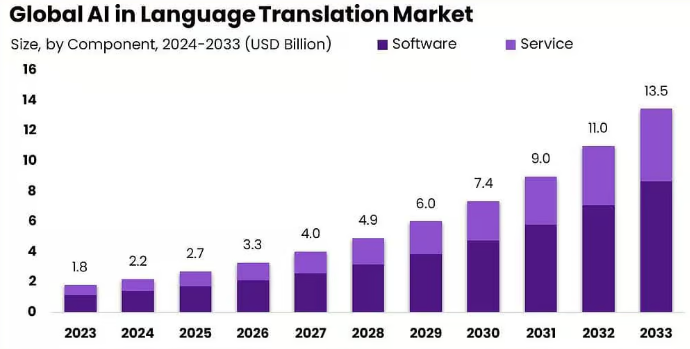
Source: Market.us
- The market size in the Language translation NLP market is projected to reach US$9.87bn in 2025.
- The market size is expected to show an annual growth rate (CAGR 2025-2031) of 23.30%, resulting in a market volume of US$34.68bn by 2031.
- In global comparison, the largest market size will be the United States (US$2.89bn in 2025).
How Does a DeepL App Work?
If you are looking to build an AI translation app like DeepL, then it is vital to know about its working mechanism. So, our Artificial Intelligence Development Services team has explained the functioning of DeepL below.
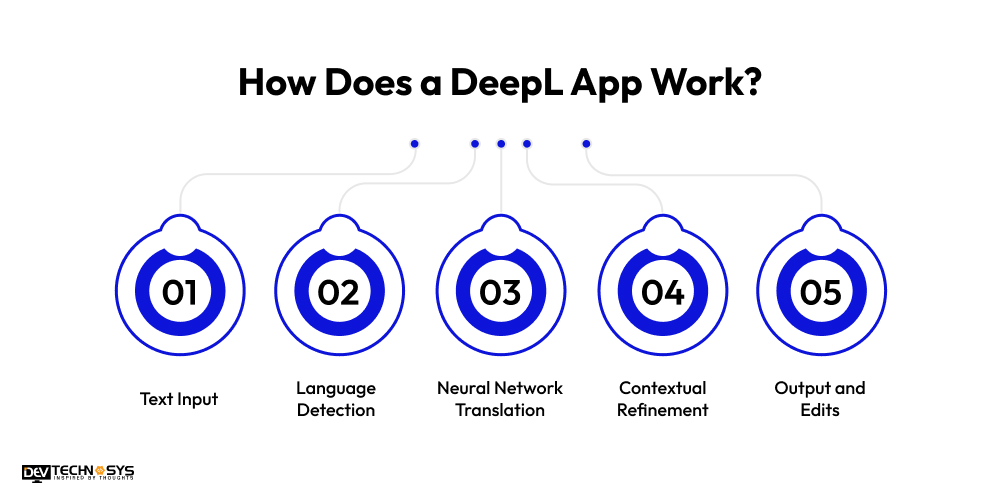
1. Text Input
You start by typing or pasting text into the DeepL app. You can also upload documents like Word or PDF files.
2. Language Detection
DeepL automatically detects the language of your input or lets you choose it manually. You also select the target language for translation.
3. Neural Network Translation
DeepL uses advanced neural networks trained on millions of translated texts. These AI models understand grammar, tone, and context to produce accurate translations.
4. Contextual Refinement
Unlike simple word-for-word tools, DeepL considers the entire sentence and even surroundings text. This helps maintain meaning, especially for idioms and complex phrases.
5. Output and Edits
The translated text appears instantly. You can copy it, edit it, or download the translated file. It also suggests alternate wordings to improve fluency and tone.
Steps To Build an AI Translation App Like DeepL
If you are planning to develop an AI translation app like DeepL, it involves integrating advanced natural language processing (NLP), machine learning, and robust infrastructure to ensure high-quality translations. Here’s a step-by-step guide to help you conceptualize, design, and develop an app like DeepL.
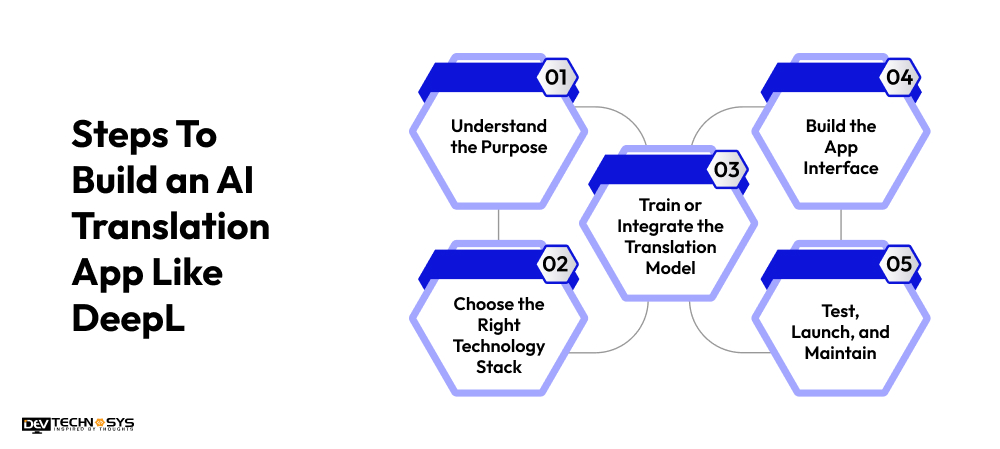
1. Understand the Purpose
Before you start to build an AI translation app like DeepL it’s important to clearly understand what you want it to do. DeepL is known for high-quality, context-aware translations. So, begin by defining your app’s main purpose, will it support text translation only, or also voice, documents, and images? Decide which languages you’ll support initially.
Plan features like real-time translation, user-friendly interface, language detection, history saving, or even offline mode. At this stage, it’s helpful to look at competitor apps like Google Translate and DeepL to understand what works well and what can be improved. Creating wireframes or mockups can help you visualize the app before development begins.
2. Choose the Right Technology Stack
Once your plan is clear, the next step is to pick the right tools and technologies to build your app. You’ll need a strong backend for handling translations and a smooth frontend for a good user experience.
For the backend, popular languages include Python, Node.js, or Java, while for the frontend, the Artificial Intelligence Development Company In UAE can use React Native or Flutter if you want your app to work on both Android and iOS.
For the AI translation engine, you can use existing models, or even open-source models like MarianMT. You’ll also need cloud services like AWS or Google Cloud for storage, server hosting, and scalability.
3. Train or Integrate the Translation Model
This is the heart of your app, how the translation actually works. You have two options: either train your own AI model or use existing APIs. Training your own model can be very powerful but requires large amounts of bilingual data and computing resources.
It involves natural language processing and deep learning techniques to understand context, tone, and sentence structure. If you’re just starting out, using APIs from providers like DeepL, OpenAI, or Google Cloud Translation is a faster and easier way to get accurate results. Later, you can consider customizing or fine-tuning models for better performance.
4. Build the App Interface
With the translation engine ready, now it’s time to bring everything together in the app to build an AI translation app like DeepL. Design the user interface to be clean, intuitive, and easy to use. Allow users to input text, select languages, and see instant results. Add features like copy, share, and voice playback if needed.
Make sure your mobile app development connects smoothly to the translation engine, whether it’s your own model or a third-party API. Also, test your app thoroughly to make sure translations are accurate, loading times are fast, and there are no bugs or crashes.
5. Test, Launch, and Maintain
Finally, test your app on different devices and with real users to catch any issues. Gather feedback to learn what users like and what they struggle with. Once everything is stable, you can launch the app on platforms like Google Play Store and Apple App Store.
But the work doesn’t stop there, continuing to improve the app by updating the translation model, adding new languages, fixing bugs, and introducing new features based on user feedback. AI and language models evolve quickly, so staying updated and continuously improving is key to staying competitive.
Key Features of DeepL App Development
When you build an AI app similar to DeepL or integrate with its API, there are several standout features that contribute to its effectiveness, user experience, and market success. Below are the major features central to DeepL app development:
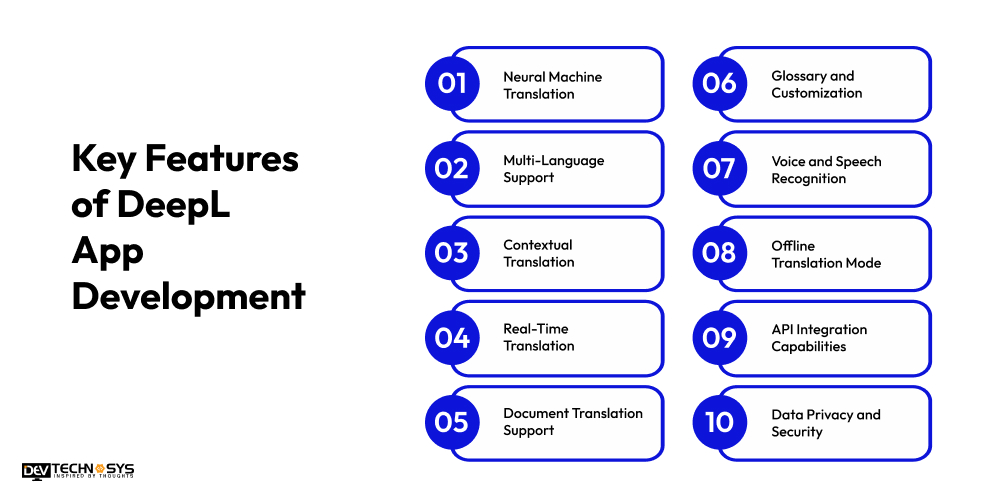
1. Neural Machine Translation
At the core of DeepL is its advanced NMT system, which delivers translations with superior fluency and accuracy compared to traditional translation engines. This technology understands the nuances of context and grammar, enabling more natural and human-like output.
2. Multi-Language Support
DeepL supports a growing number of languages including major European and Asian languages. The Artificial Intelligence in Mobile App Development can seamlessly translate text between these languages, making it ideal for global communication and business applications.
3. Contextual Translation
Unlike basic dictionary-based translations, DeepL considers the entire context of a sentence. This allows the app to choose words and structures that fit naturally, greatly reducing common errors in machine translation.
4. Real-Time Translation
The DeepL app supports instant translation, allowing users to type or paste text and receive immediate results. This feature is essential for business professionals, travelers, and students who need quick translations on the go.
5. Document Translation Support
When you build an AI translation app like DeepL, it offers the ability to translate full documents while maintaining formatting. Users can upload PDFs, Word files, and PowerPoint presentations to receive high-quality translations without manual reformatting.
6. Glossary and Customization
The AI development services team can integrate glossary features, allowing users to set specific translation rules for certain terms or phrases. This is especially useful in industries like legal, medical, or technical fields where terminology consistency is critical.
7. Voice and Speech Recognition
In advanced app versions, integration of voice-to-text and speech recognition enables spoken input, which is instantly translated and displayed or read aloud in the target language, enhancing accessibility and hands-free use.
8. Offline Translation Mode
To ensure usability without internet access, some DeepL-powered apps incorporate offline capabilities by caching commonly used languages and phrases, ensuring translation is available anywhere.
9. API Integration Capabilities
For enterprise and AI development company use, DeepL provides robust API access. This allows businesses to integrate translation features into their own platforms, websites, or software systems efficiently.
10. Data Privacy and Security
DeepL emphasizes data protection. All translations are encrypted, and for Pro users, data is not stored on servers, ensuring compliance with GDPR and other privacy standards, critical for business and legal use.
Top 4 AI Translation Apps Like DeepL
If you’re seeking AI-powered translation apps akin to DeepL, then below are the top app building software like DeepL.
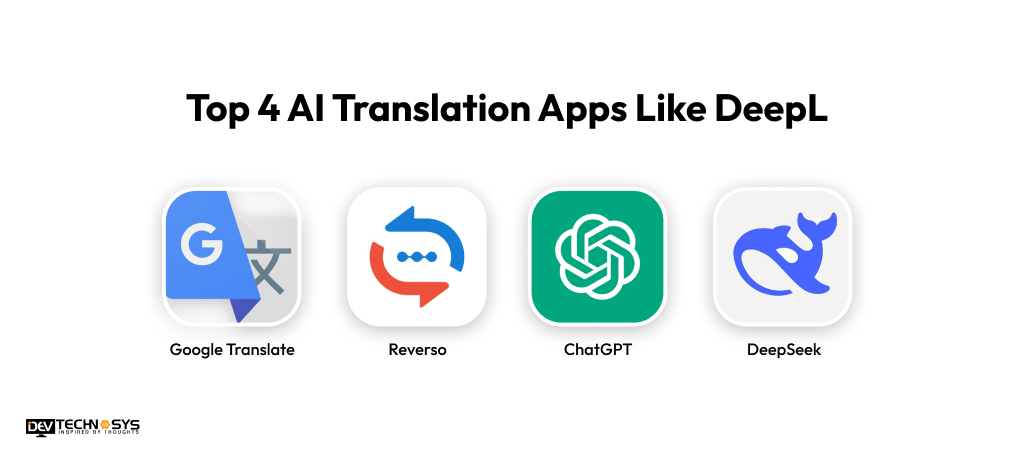
Best Apps Like DeepL |
Available Platform |
Downloads |
Ratings |
| Google Translate | Android | iOS | 1B+ | 4.4 |
| Reverso | Android | iOS | 10M+ | 4.6 |
| ChatGPT | Android | iOS | 100M+ | 4.6 |
| DeepSeek | Android | iOS | 10M+ | 3.8 |
How Much Does It Cost To Develop an AI Translation App Like DeepL?
The cost to build an AI translation app like DeepL ranges between $10,000 – $25,000. However, the DeepL app development cost can affect depending on your project requirements. So, it is vital to first set a proper budget and do planning before investing in AI translation app development. Now, let’s have a look at the cost to develop an AI translation app like DeepL.
1. Scope and Features
The complexity of the app plays a major role in determining the cost to build an app like DeepL. Basic features like text translation, language selection, and a user-friendly interface are less expensive to implement.
However, adding advanced features such as real-time voice translation, document translation, offline capabilities, and contextual learning can substantially increase development time and AI development cost.
Scope/Feature Category |
Estimated Cost Range |
| Core Machine Translation Engine | $10,000 – $12,000+ (or ongoing API costs) |
| Neural Machine Translation (NMT) Model Development | $8,000 – $12,000+ (for custom build) or $15 – $80 per million characters (for API usage) |
| Data Collection & Preparation | $10,000 – $30,000+ |
| Model Training & Optimization | $5,000 – $20,000+ (monthly cloud compute costs) |
| Contextual Analysis | Included in NMT development |
| Multilingual Support | Scales with NMT development and data |
2. AI and Machine Learning Models
At the heart of an app like DeepL is a sophisticated neural machine translation (NMT) system. Building or licensing advanced AI models requires significant investment. You can either develop custom models in-house, which involves hire dedicated developers and acquiring high computational resources, or use pre-trained models through platforms like OpenAI, Google, or AWS, which may lower upfront costs but involve recurring usage fees.
Complexity Level |
Estimated Cost Range |
| Basic Translation App | $10,000 – $15,000 |
| Medium Complexity | $15,000 – $20,000 |
| High Complexity (DeepL-like) | $20,000 – $25,000+ |
3. Language Support and Quality
Supporting multiple languages with high translation accuracy requires collecting, cleaning, and processing large multilingual datasets. The more languages the app supports, especially those with complex grammar or fewer resources, the higher the development and maintenance cost.
Feature Category |
Cost Estimation |
| Number of Languages | $10,000 – $30,000 |
| Domain Specificity | $5,000 – $10,000+ |
4. UI/UX Design and Platform Compatibility
A seamless user experience across platforms requires careful design and testing. Cost to Build An Artificial Intelligence App For Industries increases when optimizing for multiple devices and screen sizes or integrating additional accessibility features.
Sub-Category |
Estimated Cost Range |
| User Research & Analysis | $2,000 – $10,000 |
| Wireframing & Prototyping | $3,000 – $15,000 |
| User Interface (UI) Design | $10,000 – $20,000+ |
| Usability Testing | $1,000 – $5,000 |
| Total UI/UX Design | $16,000 – $20,000+ |
How To Monetize AI Translation App Like DeepL?
Monetizing an AI translation app like DeepL involves leveraging both B2C and B2B strategies. As per the AI development company in Middle east, here’s a breakdown of proven monetization methods and models that work for translation apps:
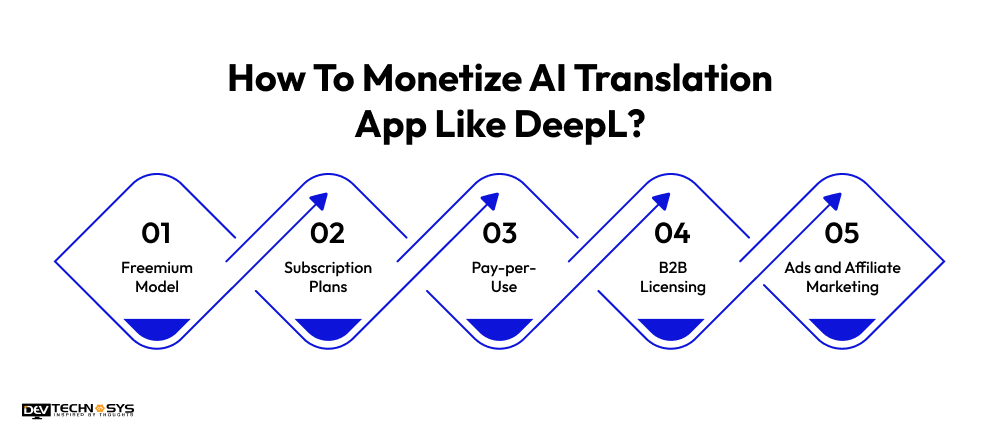
1. Freemium Model
This is one of the most popular ways to make money from an AI translation app. In the freemium model, the basic features are free for everyone. Users can translate small texts, get basic language support, and use the app casually without paying.
However, if they want more, like translating longer documents, using advanced grammar correction, or accessing premium languages (e.g., legal or medical translations), they need to pay for a subscription. This model works well because it allows people to try the app first and then decide to pay if they need more features.
2. Subscription Plans
Another great way to earn money is by offering monthly or yearly subscription packages. This is usually combined with the freemium model. Regular users, such as students, businesses, or professionals, often need translations frequently.
Offering different levels of subscription, like Basic, Pro, and Business, can meet their needs. Each plan can offer benefits like faster processing, priority support, more languages, file format support (PDF, Word), and data security. For example, DeepL offers a Pro version that charges a monthly fee for extra features.
3. Pay-per-Use
In this model, users pay only when they use the app, instead of committing to a monthly or yearly plan. This is good for occasional users who need translations just once in a while. For example, someone might want to translate a legal document or a technical paper and doesn’t want to subscribe.
They could upload the document and pay a small fee based on word count or file size. This model is flexible and easy to understand for people who don’t want long-term payments.
4. B2B Licensing
Another powerful way to monetize is by selling the translation service to other companies. Businesses around the world need translation tools to communicate with international customers, manage documents, or run global websites. You can license your app or API to companies like e-commerce stores, travel websites, or international customer service teams.
These businesses can pay a flat fee or usage-based pricing to integrate your translation tool into their systems. It’s a big opportunity because companies are usually willing to pay more for high-quality translations and professional support.
5. Ads and Affiliate Marketing
If you don’t want to charge users directly, you can make money through advertising and affiliate links. Free users can see ads while using the app, like banner ads or short video ads. You can also suggest tools or services related to language learning, writing, or education, and earn a commission when users click or buy from those links.
While ads may not bring in as much money as subscriptions, they help you make income from users who won’t pay but still use your app often.
Final Thoughts
Building an AI translation app like DeepL takes smart planning, the right tools, and a clear focus on user needs. It’s not just about tech, it’s about breaking language barriers and connecting people worldwide.
Thus, if you have a brilliant idea but need expert help, hire an AI development company in UAE to turn your vision into a powerful, user-friendly app. With the right team, your dream translation app could be the next big thing in global communication!
Frequently Asked Questions
1. How Long Does It Take To Create An AI Translation App Like DeepL?
Creating an AI translation app like DeepL can take 7–18 months, depending on team size, features, and model complexity.
2. How Much Does It Cost To Build An App Like DeepL?
Costs vary, depending on the team size, features, and complexity, but can range from $10,000 to $40,000+ for development and maintenance.
3. How To Make An AI Translation App Like DeepL?
To make an app like DeepL, follow these steps:
- Define target languages and core translation features
- Choose machine translation API or build custom model
- Design clean, intuitive multilingual UI
- Integrate speech-to-text and text-to-speech modules
- Ensure real-time translation capability
- Add user authentication and preferences
- Test accuracy across diverse languages
- Deploy with scalable cloud infrastructure
4. What Are the Benefits of DeepL App Development?
- High translation accuracy
- Supports multiple languages
- Real-time translations
- Easy integration via API
- Secure data handling
- User-friendly interface
- Fast performance
- Context-aware translations
- Desktop and mobile support
5. What Technologies Are Required to Build an AI Translation App like DeepL?
To develop an AI translation app, you’ll need Natural Language Processing, machine learning frameworks like TensorFlow or PyTorch, and large language models. You will also need a robust backend with API integration for real-time translation.



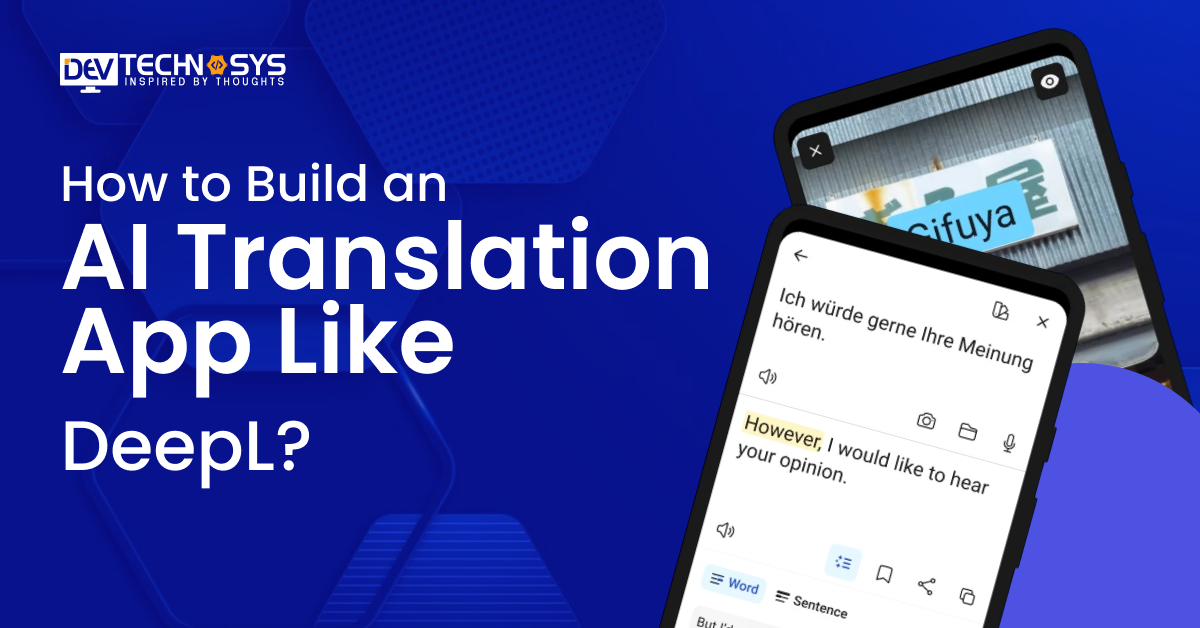



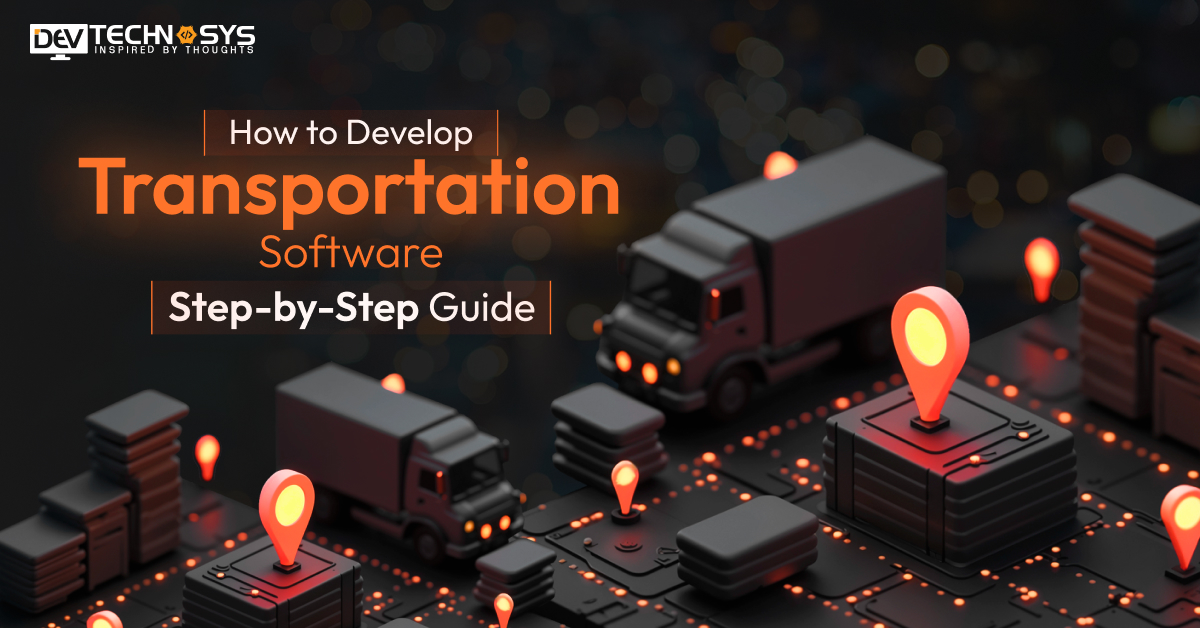
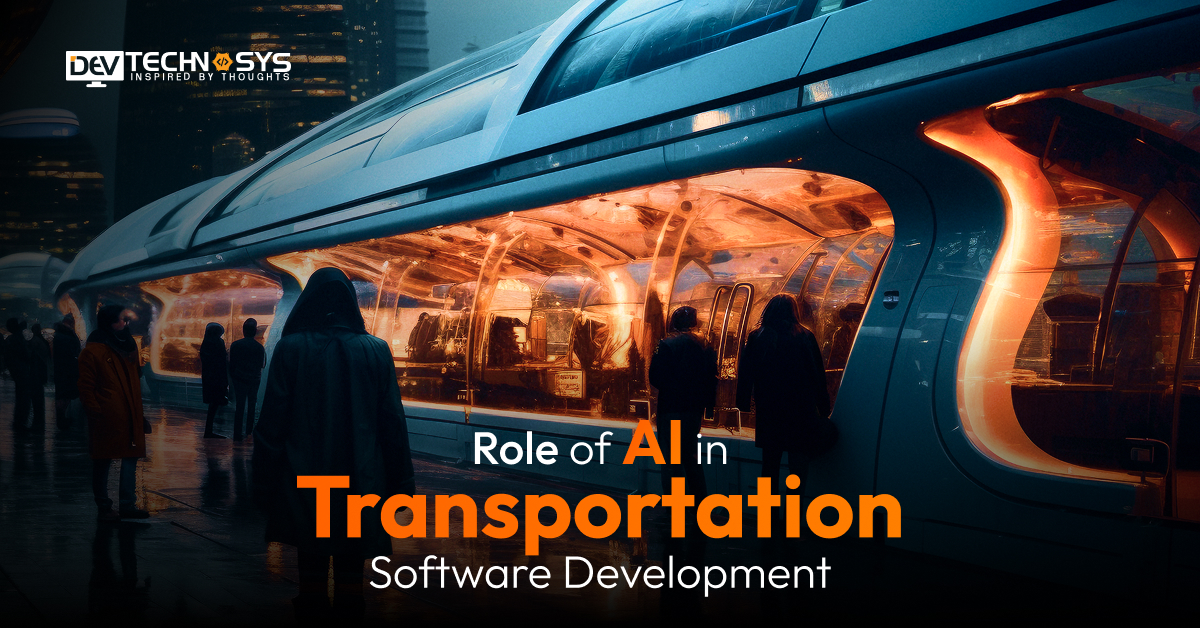
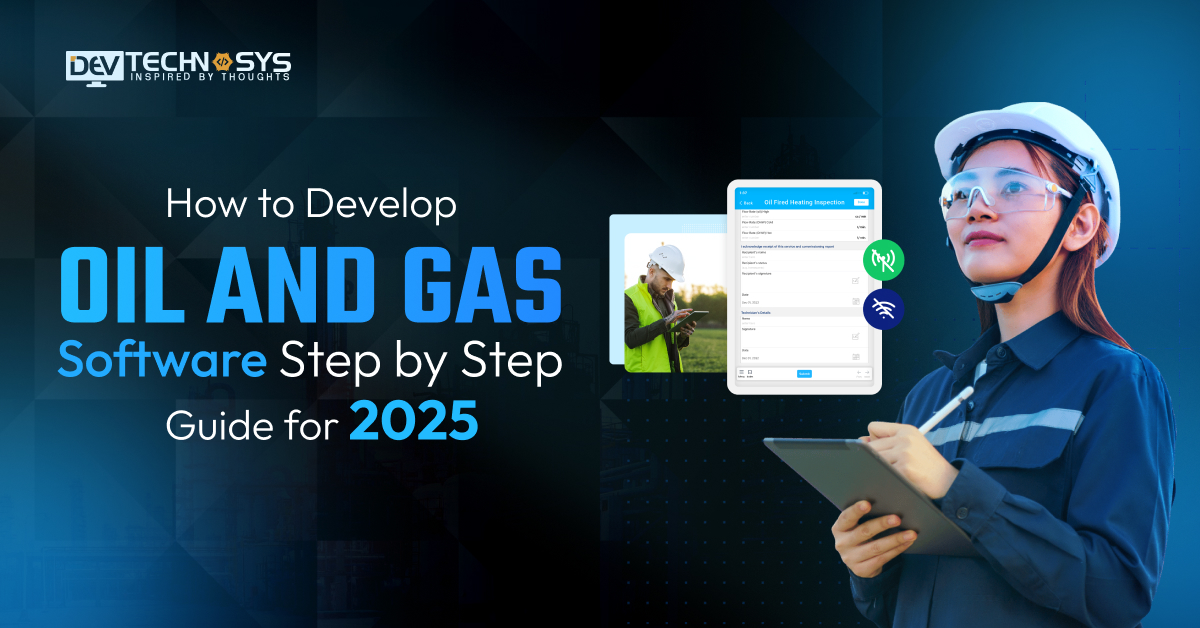






 Arabic
Arabic Dutch
Dutch English
English French
French German
German Pashto
Pashto Portuguese
Portuguese Spanish
Spanish